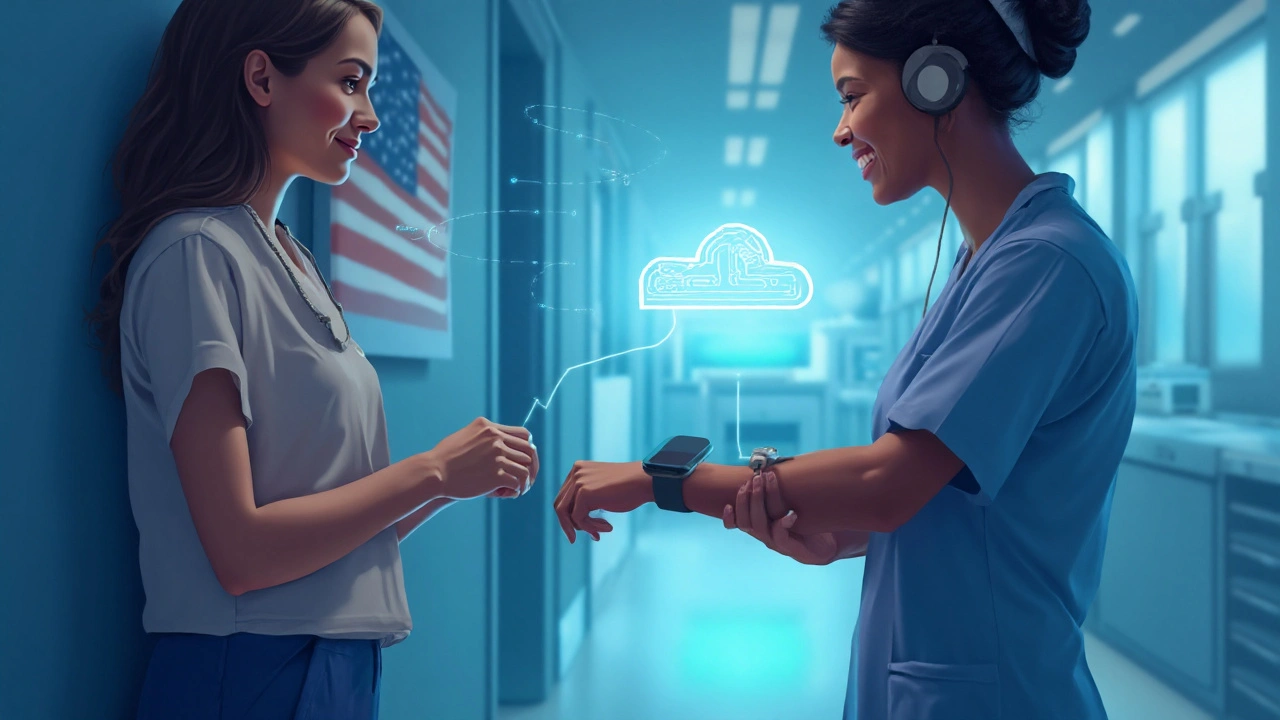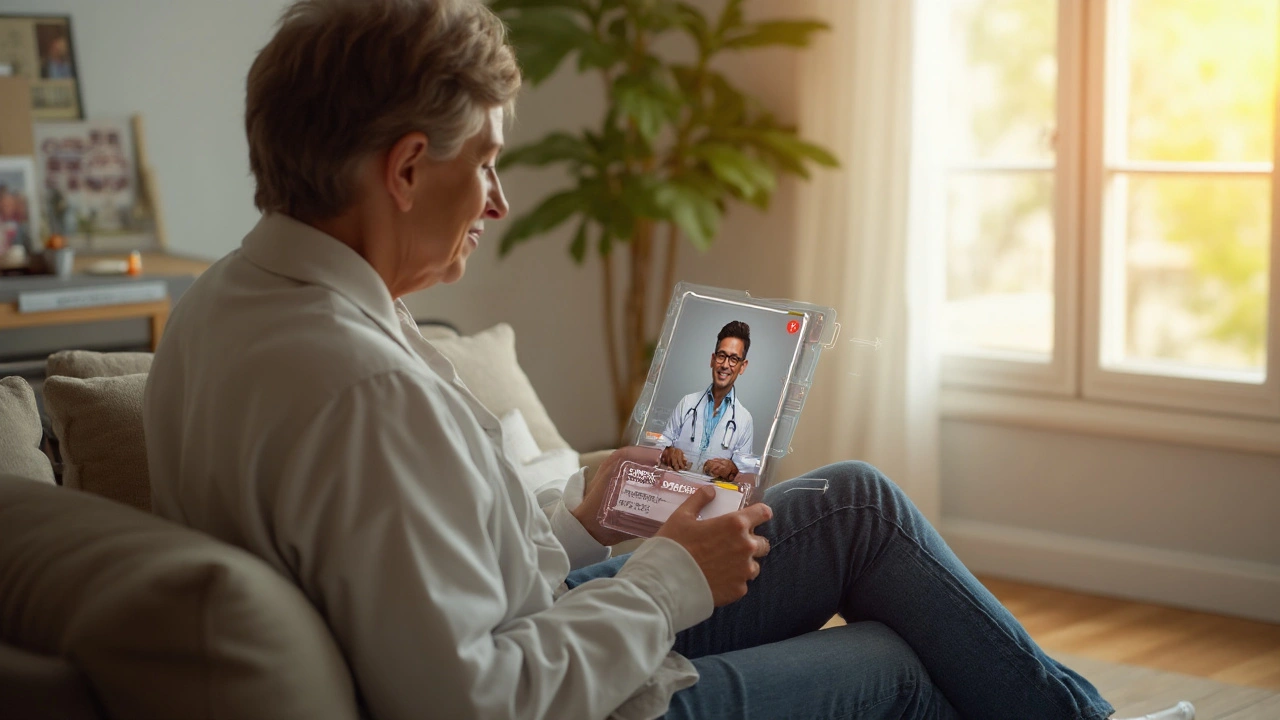Clozapine is an atypical antipsychotic medication used primarily for treatment‑resistant schizophrenia. It requires regular blood monitoring to detect agranulocytosis, a potentially life‑threatening drop in white blood cells. Because of this safety net, clozapine has a reputation for being both highly effective and logistically demanding. In the last decade, digital health tools have begun to smooth out those logistical bumps. Clozapine telemedicine now lets clinicians supervise patients from a screen, while remote monitoring devices keep a real‑time eye on blood counts and medication adherence.
Why Telemedicine Matters for Clozapine Management
Telemedicine is the delivery of clinical services via video, phone, or secure messaging, eliminating the need for patients to travel to a clinic. For clozapine users, this matters for three main reasons:
- Geographic barriers: Many patients live far from specialized psychiatric centers that can order and interpret clozapine blood tests.
- Stigma reduction: Visiting a mental‑health clinic can feel exposing; a video visit from home feels safer.
- Continuity of care: Real‑time video lets prescribers adjust dosages quickly when lab results shift.
Data from the New Zealand Ministry of Health (2023) showed a 27% drop in missed appointments among clozapine patients who switched to telepsychiatry, translating into fewer treatment interruptions.
Remote Monitoring: Turning Labs Into Living Rooms
Remote Monitoring refers to the use of digital devices to capture health data outside a traditional clinic setting. In clozapine care, the focus is on three data streams:
- Blood Monitoring devices-point‑of‑care (POC) finger‑stick analyzers that transmit neutrophil counts to an encrypted cloud.
- Wearable Sensors that track heart rate variability, sleep patterns, and movement, offering clues about early side‑effects.
- Mobile Health Apps where patients log dosing times, side‑effects, and mood ratings.
When these streams converge in an Electronic Health Record (EHR), clinicians receive a dashboard that highlights trends, flags out‑of‑range labs, and even suggests dosage tweaks via built‑in Clinical Decision Support (CDS) algorithms. The result is a proactive safety net rather than a reactive one.
Comparing Monitoring Approaches
| Method | Frequency | Typical Cost (NZD) | Regulatory Fit |
|---|---|---|---|
| In‑person venous draw | Weekly (first 6months), then bi‑weekly | 30-45 per draw | Fully compliant, but resource‑heavy |
| Point‑of‑care finger‑stick (e.g., AlereWBC) | Weekly | 15-20 per test | Approved under FDA/EMA remote‑lab guidelines |
| Home‑based capillary kit with auto‑upload | Weekly, automatic upload | 10-12 subscription/month | Emerging, requires local lab verification |
The table shows that point‑of‑care and home‑based kits cut travel costs by up to 70% while staying within regulatory boundaries. However, clinics must verify the device’s calibration and ensure data encryption.
Integrating Telemedicine into the Clozapine Workflow
A typical digital workflow looks like this:
- Patient schedules a video visit through a secure portal.
- On the day of the appointment, the patient performs a finger‑stick test using a certified device.
- The device uploads neutrophil count to the EHR in real time.
- The psychiatrist reviews the lab result, consults the CDS algorithm, and either confirms the current dose or orders an adjustment.
- Prescription is sent electronically to a pharmacy that offers home delivery.
- Wearable sensor data and app‑based side‑effect logs continue to stream for the next 7days, triggering alerts if any parameter deviates.
Studies from the University of Auckland (2024) reported a 32% reduction in hospitalization days for patients using this end‑to‑end digital loop, largely because adverse events were caught earlier.

Regulatory and Safety Considerations
Both the US FDA and the European EMA have issued guidance on remote blood monitoring for clozapine. Key requirements include:
- Device validation against a reference laboratory.
- Secure, HIPAA‑ or GDPR‑compliant data transmission.
- Clear patient consent and documentation of any technical failures.
In New Zealand, the Medsafe agency mandates that any remote monitoring system be registered as a medical device classIIb. Clinics must retain electronic audit trails for at least five years.
Benefits, Challenges, and Real‑World Tips
Benefits
- Adherence boost: Automated reminders in mobile apps improve daily dosing compliance by roughly 18%.
- Safety net: Real‑time alerts shorten the window between a falling neutrophil count and clinical intervention.
- Cost savings: Reduced travel and lab overhead lower overall treatment expenses for health systems.
Challenges
- Digital literacy gaps-older patients may need extra coaching.
- Internet connectivity issues in rural NZ can disrupt data upload.
- Regulatory lag-some insurers still require in‑person lab verification for reimbursement.
Tips for clinicians
- Run a short “technology trial” with each new patient before fully switching to remote monitoring.
- Partner with labs that offer on‑site device calibration services.
- Document every telemedicine encounter using standard CPT codes to ensure billing compliance.
Related Concepts and Future Directions
Beyond the immediate workflow, several adjacent ideas are shaping the next wave of clozapine care:
- Artificial Intelligence‑driven risk models that predict neutropenia before lab values dip.
- Pharmacogenomics testing to personalize clozapine dosing.
- Integrated care networks that link psychiatrists, primary care physicians, and pharmacists in a single digital hub.
These extensions will likely be folded into the same EHR‑based dashboard, creating a truly holistic view of each patient’s mental‑health journey.
Frequently Asked Questions
Is remote blood monitoring as accurate as a lab draw?
When using FDA‑ or Medsafe‑approved point‑of‑care devices, accuracy is within 5% of standard venous draws. Clinics must still perform a confirmatory lab test during the first month of adoption.
Can I get my clozapine prescription delivered to my home?
Yes. Many pharmacies in New Zealand now offer secure courier services that comply with the Controlled Substances Act. The prescription is sent electronically after the telemedicine visit.
What if my internet connection drops during a video appointment?
Clinics should have a backup phone line or a scheduled telephone call. The EHR logs the interruption, and the provider can reschedule if critical data (like a blood count) wasn’t captured.
Do insurance plans cover telepsychiatry for clozapine?
Most major insurers in NZ and Australia have updated their policies to include telepsychiatry, but you may need a pre‑authorization code. Always confirm coverage before switching to a fully digital model.
How do I choose a telemedicine platform for clozapine patients?
Look for platforms that are HIPAA/GDPR‑compliant, integrate with your EHR, and support device data upload. The comparison table above highlights three popular options.



i swear this is all just a big pharma ploy to get us hooked on devices so they can sell us more crap... they dont care if we live or die, just as long as the data flows and the bills keep coming in
my cousin got dropped from clozapine because the fingerstick device glitched and they thought he was dying... he was fine. just a dumb machine.
Oh please. This is the kind of tech-washing that makes me want to throw my smartphone into the Thames. You’re telling me we’ve replaced the human touch - the quiet nod, the knowing silence in a clinic waiting room - with a glowing screen and a Bluetooth-enabled prick? Pathetic. If I wanted to be monitored like a lab rat, I’d join a dystopian Netflix series.
And don’t even get me started on the ‘CDS algorithms’ - those things are trained on data from people who actually have access to healthcare. My mate in Cornwall can’t even get a GP appointment without a blood sacrifice.
I’ve been on clozapine for nearly 15 years now, and I’ve seen the whole spectrum - from the old-school monthly trips to the hospital where they’d take five vials of blood and make you sit in a room with three other people who all looked like they were about to cry, to now, where I just stick my finger in a little device while watching Netflix and it uploads straight to my psychiatrist’s dashboard.
It’s not perfect - my internet cuts out every time it rains here in the Outback - but I haven’t missed a single blood test in two years, and my neutrophil counts have been stable as hell. The app reminds me to take my meds, tracks my sleep, and even nudges me if I’ve been lying on the couch too long. I know it sounds ridiculous, but honestly? It’s given me back some dignity. No more feeling like a walking lab report.
That said, I do worry about the older folks who don’t know how to use a smartphone. My mum tried it once, thought the device was a virus, and called the police. We had to send a nurse over. So yeah, tech helps, but it doesn’t replace human support - it just changes how it shows up.
Interesting stuff. I’m a GP in rural Scotland and we’ve started piloting the point-of-care devices with our clozapine patients. The cost savings are real - we used to spend over £2000 a month just on transport vouchers and phlebotomist time.
But the real win? Patients are actually sticking with it. One guy who’d dropped out for three years came back because he could do the test while making tea. That’s huge.
Still, I’m cautious. We’ve had two cases where the device gave a false low reading and we had to rush them in. We always confirm with a venous draw in the first month. Tech is a tool, not a replacement for clinical judgment. And yes, we still need to train people on how to use it - not everyone’s a digital native, even if they’re under 50.
The integration of real-time physiological data into clinical decision-making represents a paradigm shift in psychiatric pharmacotherapy - particularly for clozapine, a drug whose therapeutic index is narrow and whose safety profile demands precision.
What’s being described here isn’t merely telemedicine - it’s an emergent form of distributed clinical governance, where the patient becomes an active sensor node in a therapeutic feedback loop. The convergence of POC diagnostics, wearable biometrics, and algorithmic decision support creates a dynamic risk-assessment architecture that supersedes the static, time-bound monitoring protocols of the 20th century.
That said, the assumption that digital literacy is a trivial barrier is dangerously naive. Cognitive load, sensory processing differences, and neurodivergent experiences are rarely accounted for in these systems. A ‘technology trial’ isn’t enough - we need universal design principles baked into the interface from the start. And while cost savings are compelling, we must ask: are we optimizing for system efficiency or patient autonomy? The two aren’t always aligned.
Finally, the mention of pharmacogenomics is promising, but we’re still years away from clinically actionable CYP1A2 and HLA-B*15:02 predictive models in routine practice. Don’t let the hype obscure the science.
Wow. So we’re just gonna let people poke their fingers and hope the app doesn’t glitch while some algorithm decides if they live or die? This isn’t innovation - it’s negligence dressed up in a Silicon Valley hoodie.
And don’t even get me started on those ‘CDS algorithms’ - trained on biased datasets, probably built by interns who think ‘neutrophil’ is a type of yoga pose. You think some guy in New Zealand with no Wi-Fi and a 2012 iPhone is gonna be okay when his blood count drops and the app says ‘no worries’? LOL.
And now they’re gonna deliver clozapine to your door? Next thing you know, they’ll be sending drones with antipsychotics and a 5-star review prompt. This isn’t healthcare. It’s a capitalist horror show with a nice UI.
Also, who approved this? The FDA? EMA? Or just some VC who got rich off telehealth during the pandemic and thinks ‘remote’ means ‘no responsibility’?
Wow so now we’re just gonna let a machine tell us if someone’s gonna die from a low white blood cell count and call it progress? 😏
Also my phone battery dies more often than my meds are taken so yeah good luck with that
but hey at least the app sends me a cute little notification saying ‘you got this’ - thanks for the emotional support, Siri